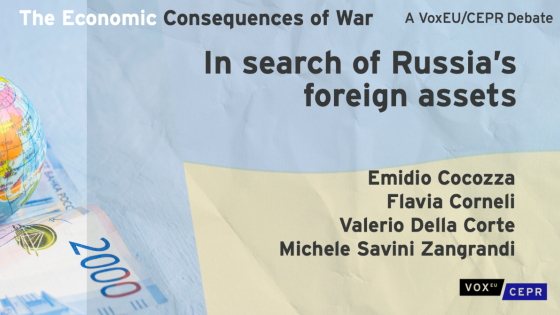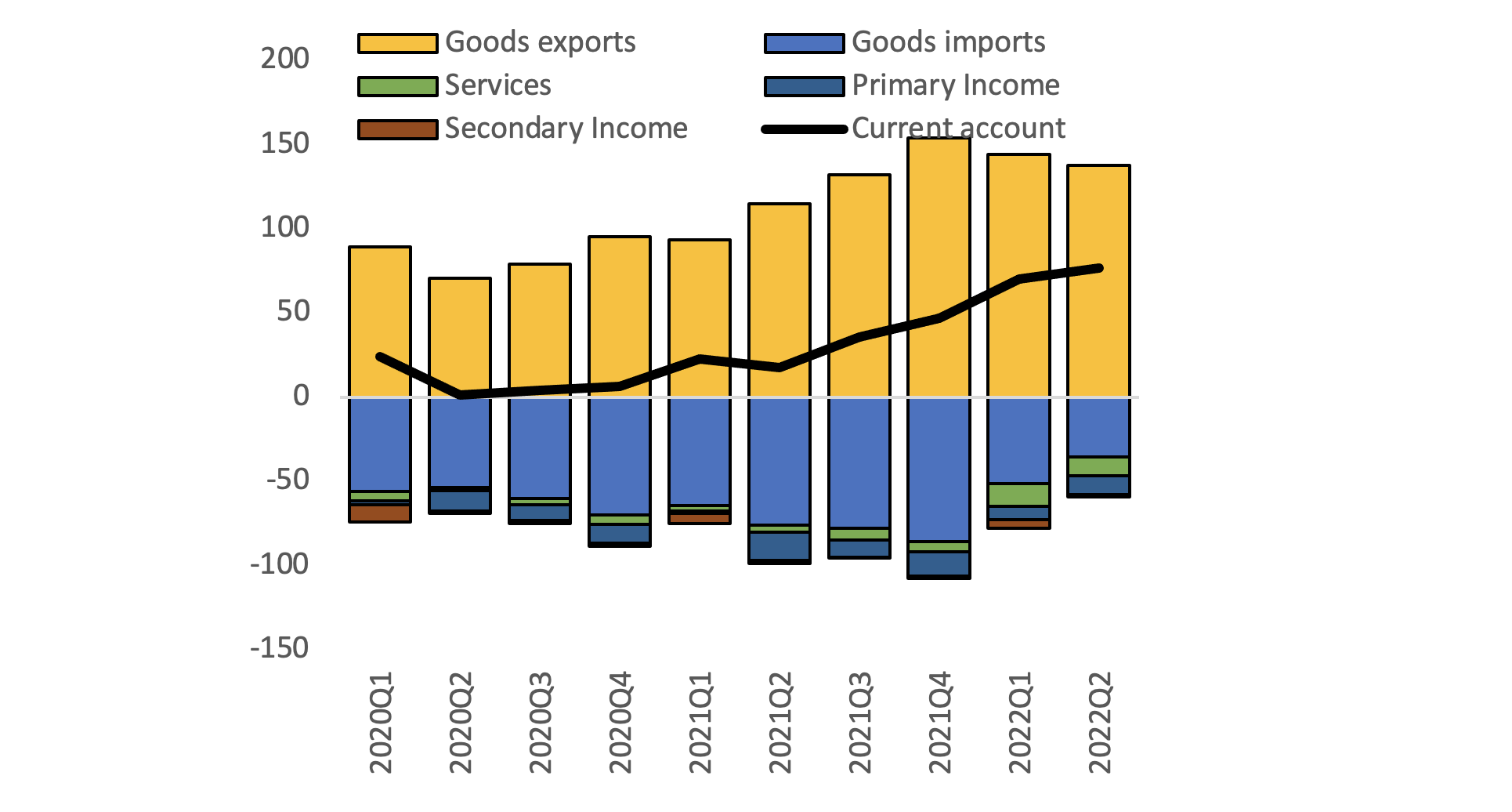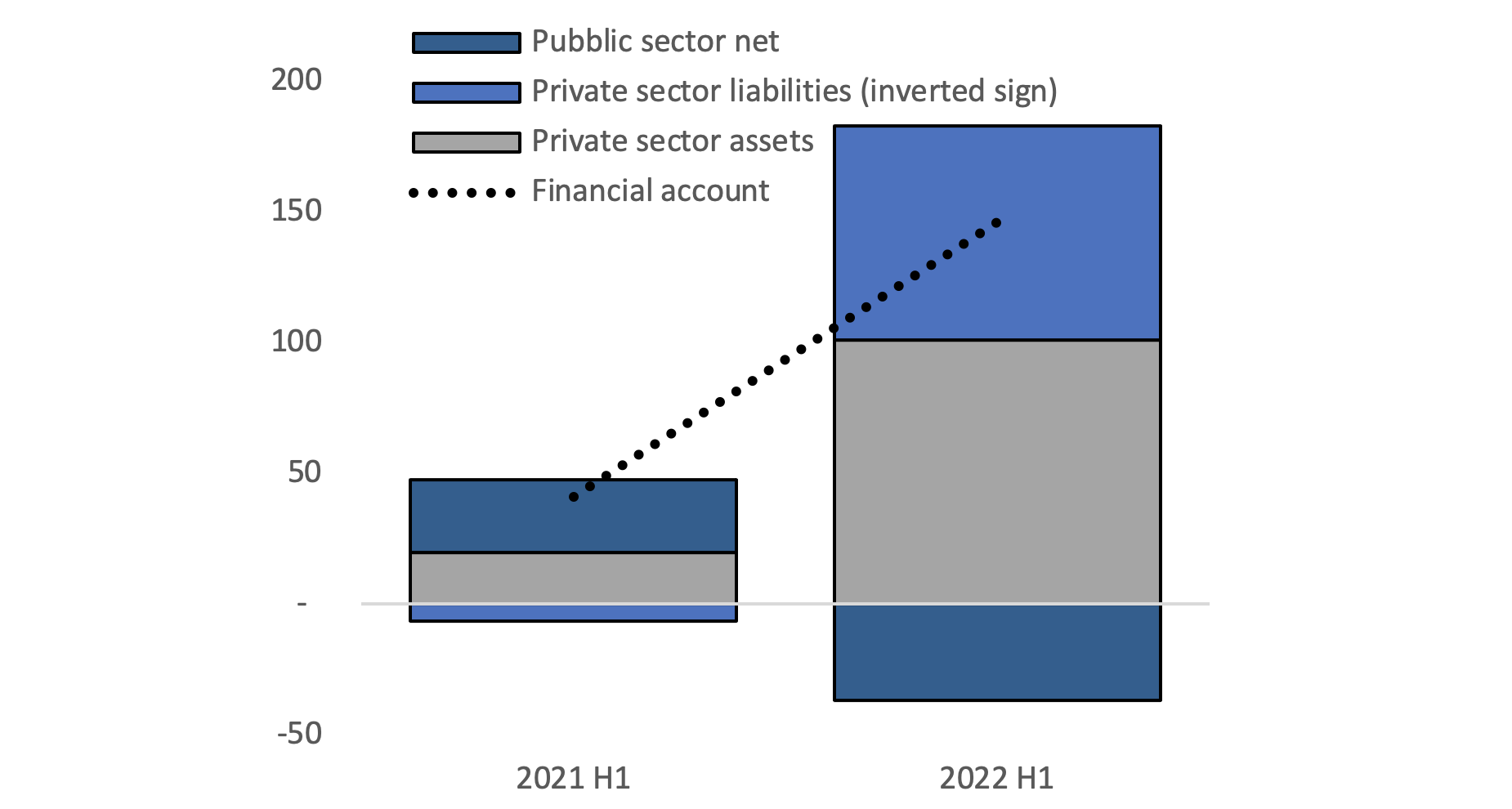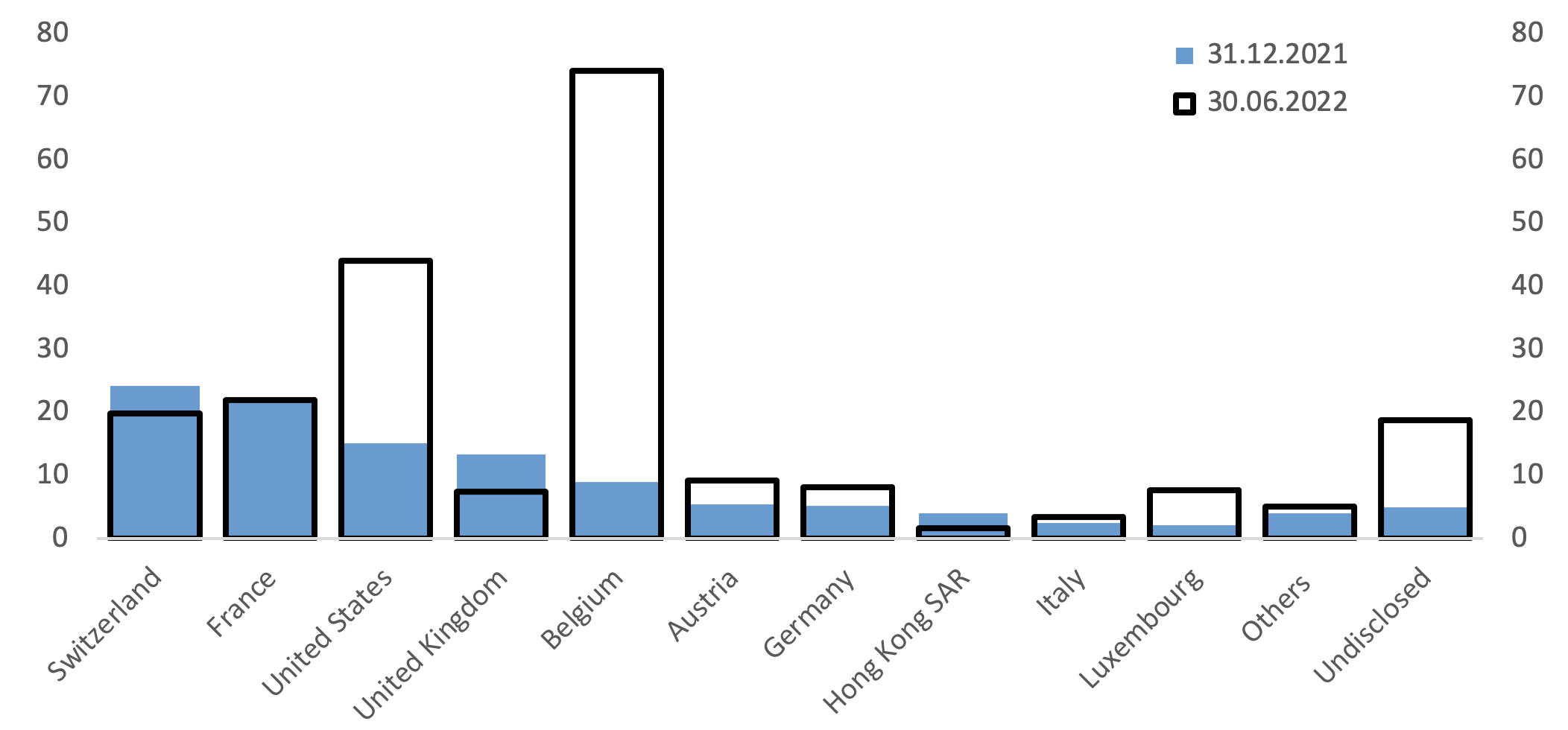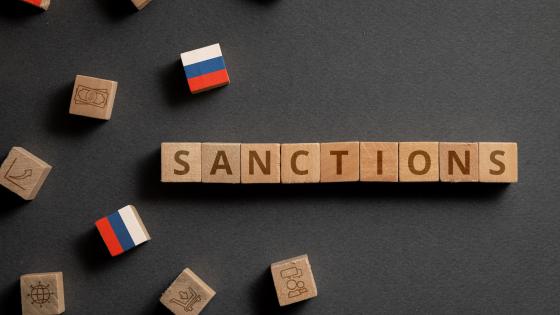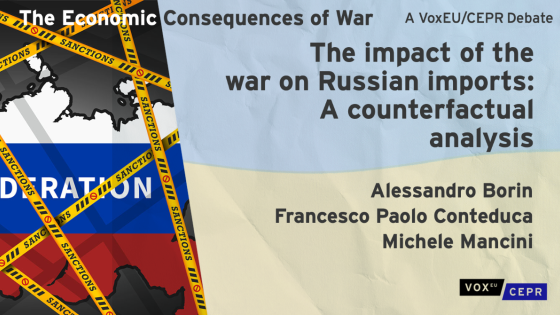On 24 February 2022, Russian troops moved into Ukraine, marking the start of the largest conflict on the European continent since WWII. An unprecedented wave of sanctions followed (Berner et al. 2022).
Financial sanctions froze approximately half of Russia’s Central Bank (CBR) international reserves (which totalled $630 billion at the end of January 2022) and hindered Russia’s largest banks’ ability to transact in the most widely used foreign currencies. Several banks were also disconnected from the SWIFT messaging system. Russian entities, including banks, were restricted from carrying out investment or financing operations in most jurisdictions. Trade restrictions, in addition, limited the export of certain goods and technologies to Russia, with substantial consequences for the Russian economy (Simola 2022).
Notwithstanding their increasing weight, sanctions have so far left hydrocarbon revenues – Russia’s chief foreign exchange earner – unencumbered, a situation that is likely to change with the implementation of new packages of sanctions on Russia’s oil exports.
The combination of high hydrocarbon prices and import compression has driven the Russian current account surplus to record heights (Figures 1 and Figure 2). In the first half of 2022, Russia posted a cumulative surplus of $147 billion (15% of GDP), equivalent to approximately half of the Russian foreign exchange reserves that were frozen at the outburst of the war.
Unprecedented accumulation of external assets
In normal times, a large current account surplus would have added to the stock of Russia’s official reserves through the implementation of the fiscal rule. This time however, with the fiscal rule suspended and the Russian central bank’s foreign operations impaired by Western sanctions, things worked out differently.
Figure 1 Current account, historical (US dollar, billions)
Source: CEIC
Figure 2 Current account, components (US dollar, billions)
Despite the release of fewer-than-usual official statistics, we can still disentangle the sources of changes in Russia’s net foreign assets position. Over the first half of 2022, Russia’s financial account exhibited a positive balance of $146 billion (Figure 3).
Figure 3 Financial account, key components (US dollar, billions)
Source: CBR, authors’ calculations.
Note: Over 2022H1, the other sectors’ assets are reported to have increased by $47 billion. Our back-of-the-envelope estimate of the change in private bank foreign assets is $55 billion. This is obtained as the difference between the consolidated banking sector acquisitions of assets reported in the Balance of Payments minus the variation in the central bank’s official reserves, that is 9 - (- 46). The variation in official reserves depends on both transactions and valuation effects, which were not negligible in the period under analysis but also cannot plausibly account for most of the drop in reserves.
The sectoral reading points to a massive improvement in the net external position of Russia’s non bank private sector, which increased by $105 billion in the first half of 2022 net of valuation adjustment. According to our calculations, the remaining surplus accrued mostly to the banking sector: although balance-of-payment statistics published since the start of the conflict consolidate the banking sector and the central bank, likely to obfuscate transactions in official reserves, the credit institution survey points to an improvement in banks’ external position by $63 billion.
As a whole, the net external position of Russia’s private sector improved by nearly $170 billion. According to our estimates, this reflects an increase in assets of approximately $100 billion and a $70 billion reduction in liabilities, with some degree of uncertainty due to the role of valuation adjustments for the banking sector.
Most of the asset accumulation happened in particularly liquid forms: the increase in ‘loans, currency and deposits’ more than offset the reduction in the direct and portfolio investment assets. Reduction in liabilities by contrast occurred across all types of financial instruments.
Where are these assets?
Information on the location of Russian assets abroad may be inferred from mirror data. The Bank for International Settlements (BIS) locational banking statistics (LBS) are a main source of mirror statistics for bank liabilities (mainly deposits), as they capture most of cross border liabilities of international active banks vis-a-vis non residents.
Figure 4 Cross-border banking liabilities to Russia (stock, US billion)
Source: BIS, Locational banking statistics.
Over the first half of 2022, locational banking statistics data show a large increase in the stock of Russian deposits in the euro area banking systems (Figure 4). The bulk of this increase took place in Belgium, where Russian deposits jumped from less than $10 billion at the end of 2021 to over $70 billion. Russian deposits in the rest of the euro area increased by $14 billion. While the BIS does not report data for all euro area countries, bilateral euro area balance-of-payments statistics confirm that during the first half of 2022 and especially in the second quarter, banking sector deposit liabilities vis-à-vis Russia recorded an unprecedented increase ($83 billion).
The increase in Russian bank deposits in Belgium is mostly linked to sanctioned entities, mainly the Russian central bank, and can be traced to amounts deposited at Euroclear (BIS 2022, ECB 2022), a large international central securities depository. According to Euroclear, funds from securities held in custody on behalf of sanctioned Russian residents could not be (and were not) transferred back to Russia when they either came to maturity or were sold (likewise for the dividend and interest income they generated) (Euroclear 2022a, 2022b). Therefore, these funds piled up on Euroclear’s balance sheet as deposits.
Locational banking statistics data also reveal a large build-up in Russian deposits in the US, where they increased from $15 billion at the end of 2021 to around $44 billion at the end of Q2 2022, with Russian banks and non-bank entities contributing approximately in equal measure to the increase. Though part of this deposit build-up might be due to blocked coupon payments and redemptions, US Department of Treasury data show that deposits belonging to Russians recorded a large drawdown in the following months. This might mean that a large part of this dollar-denominated liquidity was kept only temporarily in the US banking system by Russian entities, and later rerouted to other (more friendly) jurisdictions.
Finally, locational banking statistics data also show a surge in the stock of Russian deposits in other undisclosed reporting countries, from nearly $5 billion to close to $20 billion, likely related to increased trade with non sanctioning countries (Conteduca et al. 2022). According to press reports, the Russian National Clearing Centre (NCC) – the central counterparty in Russia’s foreign exchange market – might have played a role in foreign asset accumulation, also in the context of gas exports to the EU (Savini Zangrandi 2022), stockpiling a part of the export revenues in renminbi (RMB) (Bloomberg 2022).
Overall, locational banking statistics indicate an increase in Russian deposits abroad of about $110 billion. We assume conservatively that three fourths of the deposit build-up in the US and the entirety of those in euro area countries excluding Belgium represent a genuine asset accumulation. Adding to these two the deposits in undisclosed jurisdictions, locational banking statistics data allow tracing almost half of the $100 billion increase in private foreign assets visible through Russia’s external statistics.
Closing remarks
In the first half of 2022, the Russian private sector accumulated new foreign assets of approximately $100 billion. Looking closely at Russian and third-country financial statistics, we are able to locate approximately half of these funds in the form of bank deposits. The largest part of these deposits was located – up to the second half of 2022 – in sanctioning jurisdictions. Given the presence of non-sanctioned entities and various types of sanction-exceptions, the presence of these funds does not constitute evidence of sanction violations per se. We also detect a smaller but non-negligible share of funds in other undisclosed jurisdictions.
Our finding raises an additional question: why didn’t the Russian private sector shift its resources to safer locations right away? We speculate that Russia’s private sector was unprepared to move such a large amount of resources to less familiar jurisdictions and, on the other hand, that intermediaries in non-sanctioning countries were not able (or not willing) to absorb such large financial inflows in a short time. We take this as evidence of the difficulty in finding alternatives to the western financial system.
With regards to funds that we were unable to trace, little can be said: these might be held in the form of securities, for which timely mirror statistics are generally unavailable, or might have been rerouted to countries non reporting to the Bank for International Settlements and to central banks of friendly countries.
Authors’ Note: The views expressed are personal and do not necessarily reflect the views of the Bank of Italy or the European Central Bank. We are grateful to Alessandro Borin, Riccardo Cristadoro, Silvia Fabiani, Stefano Federico, Alberto Felettigh, Claire Giordano, Giorgio Merlonghi and Giovanni Veronese for thoughts and comments.
References
Bank of International settlements (2022), “Statistical release: BIS international banking statistics and global liquidity indicators at end-June 2022”, 31 October.
Berner, R, S Cecchetti and K Schoenholtz (2022), “Russian Sanctions: Some Questions and Answers”, VoxEU.org, 21 March.
Bloomberg (2022), “Russia Export Windfall finds Sanctions Haven in Yuan, Quasi-Bank”, 28 October.
Conteduca, F P, M Mancini and A Borin (2022), “The impact of the war on Russian imports: A counterfactual analysis”, VoxEU.org, 9 November.
Euroclear (2022a), “Euroclear delivers a strong performance for H1 2022”, 25 July.
Euroclear (2022b), “Euroclear continues to outperform”, 28 October.
European Central Bank (2022), “Euro area linkages with Russia: latest insights from the balance of payments”, Economic Bulletin, July.
Savini Zangrandi, M (2022), “Ruble payments: Shielding the ruble from financial sanctions”, VoxEU.org, 25 July.
Simola, H (2022), “War and sanctions: Effects on the Russian economy”, VoxEU.org, 15 December.
